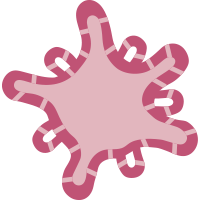
Organoid News
Organoid News is an online resource dedicated to the latest research about and featuring organoids.
Low-Intensity Ultrasound Ameliorates Brain Organoid Integration and Rescues Microcephaly Deficits
[Brain] Investigators reported that low-intensity ultrasound significantly increased neural progenitor cell proliferation and neuronal maturation in cortical organoids.
Screening Splice-Switching Antisense Oligonucleotides in Pancreas-Cancer Organoids
[Nucleic Acid Therapeutics] Scientists reported an efficient antisense-oligonucleotide lipofection method to systematically evaluate and screen individual splicing events as therapeutic targets in pancreatic ductal adenocarcinoma organoids.
Mapping of Mitogen and Metabolic Sensitivity in Organoids Defines Requirements for Human Hepatocyte Growth
[Nature Communications] Researchers characterized hepatocyte organoid outgrowth using temporal transcriptomic and phenotypic approaches. fetal hepatocytes initiated reciprocal transcriptional programs involving increased proliferation and repressed lipid metabolism upon initiation of organoid growth.
Brain Organoids Engineered to Give Rise to Glia and Neural Networks after 90 Days in Culture Exhibit Human-Specific Proteoforms
[Frontiers In Cellular Neuroscience] Scientists demonstrated that cell fate and composition of unguided brain organoids was dictated by culture conditions during embryoid body formation, and that culture conditions at this stage could be optimized to result in the presence of glia-associated proteins and neural network activity as early as three-months in vitro.
Efficient Hepatocyte Differentiation of Primary Human Hepatocyte-Derived Organoids Using Three Dimensional Nanofibers (HYDROX) and Their Possible Application in Hepatotoxicity Research
[Scientific Reports] Researchers attempted to culture human liver organoids established from cryopreserved primary human hepatocytes (PHH-derived organoids), using HYDROX, a chemically defined 3D nanofiber. While the proliferative capacity of PHH-derived organoids was lost by HYDROX-culture, the gene expression levels of drug-metabolizing enzymes were significantly improved.
Establishment of Human Hematopoietic Organoids for Evaluation of Hematopoietic Injury and Regeneration Effect
[Stem Cell Research & Therapy] To manufacture hematopoietic organoids, researchers obtained CD34+ hematopoietic stem and progenitor cells from human embryonic stem cells using stepwise induction and immunomagnetic bead-sorting.
Heterozygous RB1 Mutation Enhanced ATP Production in Human iPSC-Derived Retinal Organoids
[Molecular Biology Reports] Scientists gained further insight into the molecular disruptions in the RB1+/− retinal organoids, they performed a high throughput RNA sequencing analysis.
Synergistic Hyperactivation of Both mTORC1 and mTORC2 Underlies the Neural Abnormalities of PTEN-Deficient Human Neurons and Cortical Organoids
[Cell Reports] Investigators showed that pluripotent stem cell-derived phosphatase and tensin homolog (PTEN) mutant human neurons, neural precursors, and cortical organoids recapitulated disease-relevant phenotypes, including hypertrophy, electrical hyperactivity, enhanced proliferation, and structural overgrowth.
First Model of the Brain’s Information Highways Developed
[Informationsdienst Wissenschaft] Placenta organoids created from cultured human placenta cells have been used to shed light on several types of infection in early pregnancy
ARID1B Controls Transcriptional Programs of Axon Projection in an Organoid Model of the Human Corpus Callosum
[Cell Stem Cell] Researchers found that neurons expressing SATB2, a determinant of callosal projection neuron (CPN) identity, show impaired maturation in ARID1B+/− neural organoids.
Cerebral Organoids Display Dynamic Clonal Growth and Tunable Tissue Replenishment
[Nature Cell Biology] Investigators implemented whole-tissue lineage tracing by genomic DNA barcoding in 3D human cerebral organoids, to show that individual stem cell clones produced progeny on a vastly variable scale.
High-Fat Diet Enhances Cell Proliferation and Compromises Intestinal Permeability in a Translational Canine Intestinal Organoid Model
[BMC Molecular And Cell Biology] Investigators assessed the multifaceted interactions between palmitic acid, cell proliferation, and the intestinal epithelial barrier using a canine colonoid model. Canine models, due to their relevance in simulating human intestinal diseases, offer a unique platform to explore the molecular mechanisms underlying high-fat diet-derived intestinal dysfunction.
Organoids are three-dimensional cell cultures that more accurately model cell behavior, organ function, and pathology than traditional two-dimensional cell culture. Organoid News was launched in 2020 to help scientists stay up-to-date with this revolutionary new research system. Use Organoid News to stay current with the latest applications and discoveries using organoids, as well as new reviews, jobs, news, and upcoming events.

 Cancer Stem Cell News
Cancer Stem Cell News Cell Therapy News
Cell Therapy News Dermal Cell News
Dermal Cell News Endothelial Cell News
Endothelial Cell News ESC & iPSC News
ESC & iPSC News Extracellular Matrix News
Extracellular Matrix News Hematopoiesis News
Hematopoiesis News Hepatic Cell News
Hepatic Cell News Human Immunology News
Human Immunology News Immune Regulation News
Immune Regulation News
 Intestinal Cell News
Intestinal Cell News Mammary Cell News
Mammary Cell News Mesenchymal Cell News
Mesenchymal Cell News Muscle Cell News
Muscle Cell News Neural Cell News
Neural Cell News Organoid News
Organoid News Pancreatic Cell News
Pancreatic Cell News Prostate Cell News
Prostate Cell News Pulmonary Cell News
Pulmonary Cell News
